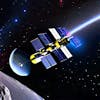Cosmic Girl Arrives

Astronomy Daily – The Podcast is available on Apple Podcasts and Spotify:
Apple Podcasts: https://podcasts.apple.com/us/podcast/astronomy-daily-the-podcast/id1642258990
Spotify: https://open.spotify.com/show/2kPF1ABBW2rCrjDlU2CWLW
Andrew’s...
Astronomy Daily – The Podcast is available on Apple Podcasts and Spotify:
Apple Podcasts: https://podcasts.apple.com/us/podcast/astronomy-daily-the-podcast/id1642258990
Spotify: https://open.spotify.com/show/2kPF1ABBW2rCrjDlU2CWLW
Andrew’s taking a short holiday…so for the next little while Astronomy Daily – The Podcast will be hosted by his brother Steve…and Halley of course.
Monday October 24, 2022
Today’s headline stories:
Ever stepped on a Lego in the middle of a dark night? Yeah… Me too.
Just be thankful you don’t have to pay the Ukraine’s Starlink account.
Virgin take delivery of their new carrier aircraft, Cosmic Girl and Japan’s Geotail probe has tragically lost its last surviving data recorder.
Happily, NASA has cleared their EVA suits for spacewalks again and researchers are still pondering interstellar objects following a mysterious visitor five years ago…
Oh, and I brought some musos into the studio for a change…
These stories and more in this episode…
If you’d like to find out more about the stories featured in today’s show, you can read today’s edition of the Astronomy Daily Newsletter at any of our websites – www.spacenuts.io , www.bitesz.com or go directly to www.astronomydaily.io – subscribe and get the new edition delivered to your mailbox or RSS reader every day….it’s free from us to you.
Please subscribe to the podcast and if you have a moment, a quick review would be most helpful. Thank you…
#space #astronomy #science #podcast #astronomydaily #spacenuts #spacetime #cornwall #newquay
Steve: Welcome back, everybody. It's astronomy daily for another day. I'm, um, Steve Dunkley, sitting in for Andrew Dunkley, who's away on hiatus checking out the rest of the planet with your guest host, Steve Dunkley.
Halley: Hey, Steve. The backroom studio is full of musicians. What gives?
Steve: Yes, I've just got something special planned for one of the stories.
Halley: Something special?
Steve: Just a little something for fun.
Halley: Andrew warned me about your musical surprises.
Steve: Oh, it's nothing too dramatic, Halley.
Halley: Well, the sheet music is called Dramatic Thing. Sounds dramatic to me.
Steve: Oops, cats out of the bag, then.
Halley: Well, okay then. Do your worst, you crazy guy.
Steve: Time for the news, Halley. You first.
Halley: Okay, then, here's some news. Virgin Orbit's Cosmic Girl carrier plane has arrived in Cornwall in preparation for the first ever orbital launch from the United Kingdom. Cosmic Girl. A modified Boeing 747 carrier aircraft landed at Nukeway Airport in Cornwall on October 11. Virgin Orbit is targeting a November takeoff from Spaceport Cornwall to launch the pioneering start me up mission. Cosmic Girl will carry a launcher one rocket with it under its wing before releasing it in the upper atmosphere. The two stage rocket will then do the rest of the work to send eight small satellites into orbit for a range of government and commercial customers. The mission is set to be the first orbital launch from the United Kingdom and the first commercial launch from Western Europe. This is a huge moment for us all in Cornwall as the journey to UK space launch has officially begun, melissa Thorpe, head of Spaceport Cornwall, said in a statement. It will also be the first international launch for Virgin Orbit, which has so far launched five missions since 2020. It's understandable if you're a bit confused about the situation with SpaceX's Starlink satellite Internet service in Ukraine. Starlink, SpaceX's giant and evergrowing broadband constellation, has been a vital piece of Ukrainian communications infrastructure throughout the ongoing Russian invasion. Ukrainian government officials publicly requested Starling terminals on February 26, just two days after the invasion began, and the first ones arrived in the country on February 28. SpaceX is footing the bill for most of these terminals, Musk said, and the cost is far from nominal. The company currently charges $110 per month for standard Starlink service per terminal, plus an initial one time hardware cost of $599. And this is where the confusion comes in. There's been a lot of back and forth on Twitter and in the media over the past four days about the cost of SpaceX's Ukraine commitment and the company's continued willingness to pay it after initially saying that SpaceX had asked the US. Military to start paying for the Ukrainian government's use of Starlink. Just a day later, however, Musk publicly backtracked from this request for Pentagon dollars. To hell with it. Even though Starlink is still losing money and other companies are getting billions of taxpayer dollars, we'll just keep funding Ukraine government for free. The billionaire entrepreneur wrote on Twitter. On October 1970, the Soviet Union launched the Zand Eight spacecraft on a mission to the moon. This was the last mission in the Zond program after the first three Zond missions explored Venus and Mars. The next ones were circumlunar missions that flew around the Moon before returning to Earth. Although there was no crew on board, the Zon spacecraft was designed with Cosmonauts in mind. The Zond missions served as test flights for the Soviet Union's plans to send Cosmonauts to the moon. But those plans for crewed flights never came to fruition. This was partly because the US. Had already put astronauts on the Moon, but also because the Zond missions had a lot of technical problems. Zond Eight was considered a success even though its guidance system malfunctioned on the way back to Earth. The spacecraft still returned to Earth safely and splashed down in the Indian Ocean one week after it launched. The second and only remaining operational data recorder aboard NASA's magnetosphere observing Geotale spacecraft has failed, jeopardizing a mission that has been in operation for three decades. NASA scientists are working with the Japan Aerospace Exploration Agency, JAXA and Japan's Institute of Space and Astronautical Science ESAs partners on the Geotail mission to determine the best path forward for the project. Since the discovery, scientists have been conducting tests to determine the cause and extent of the damage, a uh NASA spokesperson said. Attempts to recover the second data recorder have thus far been unsuccessful, and without a working recorder, Geotail can't collect or download data. After a sevenmonth hiatus, NASA spacewalks outside the International Space Station are back on. NASA halted routine us. Spacewalks after European Space Agency astronaut Matthias Mauer noticed a higher thannormal buildup of water inside his helmet after a nearly sevenhour excursion on March 23. The agency has now completed a review of the incident, finding that it was not a leak caused by hardware issues. Instead, the water was condensation caused by high levels of astronaut exertion and the cooling setting on Morris extravehicular mobility unit spacesuit, NASA officials said. With this information in hand, the agency has approved the resumption of routine spacewalks, with the next one set to take place in mid November. Crew safety is the top priority of NASA and its international partners, a NASA spokesperson said. And that's all I have for you today.
Steve: Oh, thank you very much. Hallie thank you for that. Now, you remember Almuhua, uh, the object five years ago that passed through our solar system? Well, scientists are still trying to work out what was going on. Scientists are still figuring out what the strange object says about planetary systems. Marauding ice giant planets like Neptune could be flinging many trillions of small bodies into interstellar space, some of which visit solar systems as oumuamua did in 2017. If true, then the population of such rogue objects moving between the stars could be in the hundreds of trillions of trillions that's a digit followed by some 26 zeros. Oumuamua um was discovered on October 19, 2017, having arrived from interstellar space where it is headed once more after swinging through our solar system and the existence of small bodies visiting from interstellar space wasn't a surprise. In fact, interstellar interlopers such as Alumua and Borisov, the only two discovered so far, had been predicted long before. We know that when the solar system was forming, several dozen Earth masses worth of small icy bodies would have been ejected into the interstellar medium, Greg Loughlin, an astronomer at Yale University, told Space.com. So if you take our solar system as a representative example then you would expect to have quite a bit of stuff drifting through interstellar space. He said the mechanism that ejects these myriad of small bodies is a result of planetary migration, in particular the rampage of giant planets. Any model that has any sort of movement of giant planets as they are forming emits to sea of uh planetesimals is going to produce interstellar objects, he said. Loughlin and Caltech astronomer Constantine Battogen coined the term throw line as description of where such ejections can take place. The throw line is just a riff on the term snow line, Laughlin said, referencing the distance from a star where water is more stable as ice than vapor. The throw line in the turn is located where a giant planet is able to slingshot a small body with enough acceleration to achieve escape velocity from the gravitational pull of its star. In our solar system, according to Loveland, the throw line is at about 372,000,000 miles. That's about 600 million km from the sun. All four of the gases in our neighborhood jupiter, Saturn, Uranus and Neptune Ah are beyond the throw line and all could have ejected bodies into interstellar space. But the process doesn't necessarily need all four, where the escape velocity is low and there are plenty of icy bodies to throw around. Neptune would have acted as the solar system's bouncer as the planet migrated outward, ejecting many of the small bodies that got in its way. If Almuamua is typical then that's suggesting that the average star is Neptune like planet just as a solar system, Loughlin said, adding that there is observational evidence to support this in the form of images taken by Alma. That's the uh Atacama Large Millimeter submillimeter array of planet forming disks of dust around young stars. Many of these disks appear to have ring shaped gaps in them that may have been cleared out uh, by the gravity of Neptune like worlds. And while this may not sound like a revelation, it's important for astronomers who have been seeking to determine just how typical or atypical house solar system is compared to systems around other stars. However, the predicted abundance of interstellar objects implies that the architecture of our outer solar system at least may be fairly regular. Now I don't want to sound like I'm doing a promo here and maybe it's because Christmas is rearing its ugly head again. But I've just come across a great new set of products from Lego all space themed, of course. And being a brand new grandfather, I'm getting clued in on all the new kids stuff, all the new toys, but hold up. Space themed Lego? Uh, could this possibly be aimed at us big kids, too? Thanks, boys. Take five. Well, Lego, as you know, has been around for more than 60 years, with the earlier space theme sets dating back to about the 1960s, going from very simple builds to huge, detailed recreations of actual NASA technology. And Lego space sets have obviously come a very long way in that time. In fact, the space themed sets remain one of Lego's most popular themes, however catering for children and adults alike. Yes, it's the big grown up kids that are probably making this theme, uh, super popular. Well, probably. Sure, there's a heap of kid branded rocket ships with a ton of familiar characters included, like Mickey Mouse and so on. And who hasn't perused the Lego's seemingly infinite collection of Star Wars vehicles? I know I have. There's even a great range of Lego city space themed sets, like one based on NASA's real life Artemis project. But for us grown up kids, it's the really big Lego sets that gets us excited. There's a 2354 piece replica of the NASA space shuttle Discovery, for example, or the delicate but oh so accurate Apollo Eleven Lunar Lander. Oh, yeah. But I'm not saying go buy that. I'm just saying way cool, huh? Considering the countless painful times I've encountered a stray Lego block on the living room floor in the dead of night. I mean, who hasn't shared that pain with me, right? I think it's the space themed sets that make up for it. Maybe just a bit, huh? And that's all we have for this episode of Astronomy Daily, a slightly musical version. Thank you for joining us, and remember, you can catch up on all the episodes of Space Nuts with Andrew Duncany and Professor Fred Watson, as well as every episode of our podcast, Astronomy Daily, at this address. Space nuts. IO. Uh, so head over there and click the links and enjoy your fill of space science and stuff. And a big thank you to the boys in the band for providing us a dramatic for my story today. Thank you, flashjack and the warmer at Downrange Combo. Love your work. I'm Steve Duckley, keeping the studio chair warm while my big bro is off measuring the curvature of the Earth. Thank you, Hallie, for the help, as always, and for looking after the band.
Halley: Your music pals are quite nice for Human Steve.
Steve: Uh, I see trouble coming.
Halley: I'm going to the sound bar with the band. See you all later.
Steve: She's a social media butterfly, that one. Bye. With your guest host, Steve Duncany.
New to Astronomy Daily - The Podcast?
Here are some great episodes to start with.













